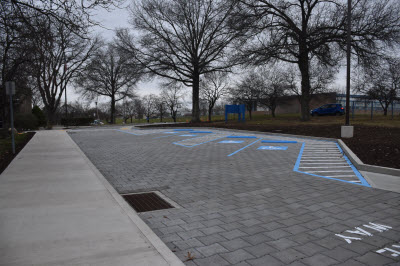A Flooding Fix for Monroeville Public Library
Stormwater Improvements Reduce Flooding, Improve Accessibility
Allegheny County Conservation District recently completed the installation of stormwater best management practices (BMPs) at the Monroeville Public Library. The entrance of the library frequently flooded during rain events when water came through the entrance doors.
As part of a larger initiative with Westmoreland Conservation District to install stormwater BMPs in the Turtle Creek Watershed, ACCD worked with the library and Municipality of Monroeville to install a new permeable paver access drive with handicap parking, a rain garden and improved drainage at the main entrance doors.

Improvements include a new front driveway and walkway, four accessible parking spaces, new lighting and sidewalks with accessible ramps.
The permeable pavers and rain garden will capture approximately 2,800 cubic feet of stormwater from the adjacent roadway where it can be slowly absorbed into the ground. In addition to stopping the flow of water toward the library, these BMPs will prevent nutrients and sediment commonly found in roadway runoff from flowing into Turtle Creek. This will ultimately improve water quality and reduce stormwater volumes that cause flooding in the watershed.
Overall, the Turtle Creek Stormwater Management Project retrofitted 17 project sites in Allegheny and Westmoreland Counties with stormwater management practices in areas that lack these practices altogether or where existing practices have proven to be inadequate.
In addition to the work at Monroeville Public Library, Westmoreland Conservation District provided designs for BMPs in both counties that included 12 retrofitted detention basins in the municipalities of Penn Township, Murrysville and Monroeville. These basins now treat approximately 493,000 cubic feet of runoff from a one-inch storm on approximately 136 acres of developed land.
A Pennsylvania Growing Greener Grant administered through the Penn’s Corner Conservancy Charitable Trust to both conservation districts funded the project.